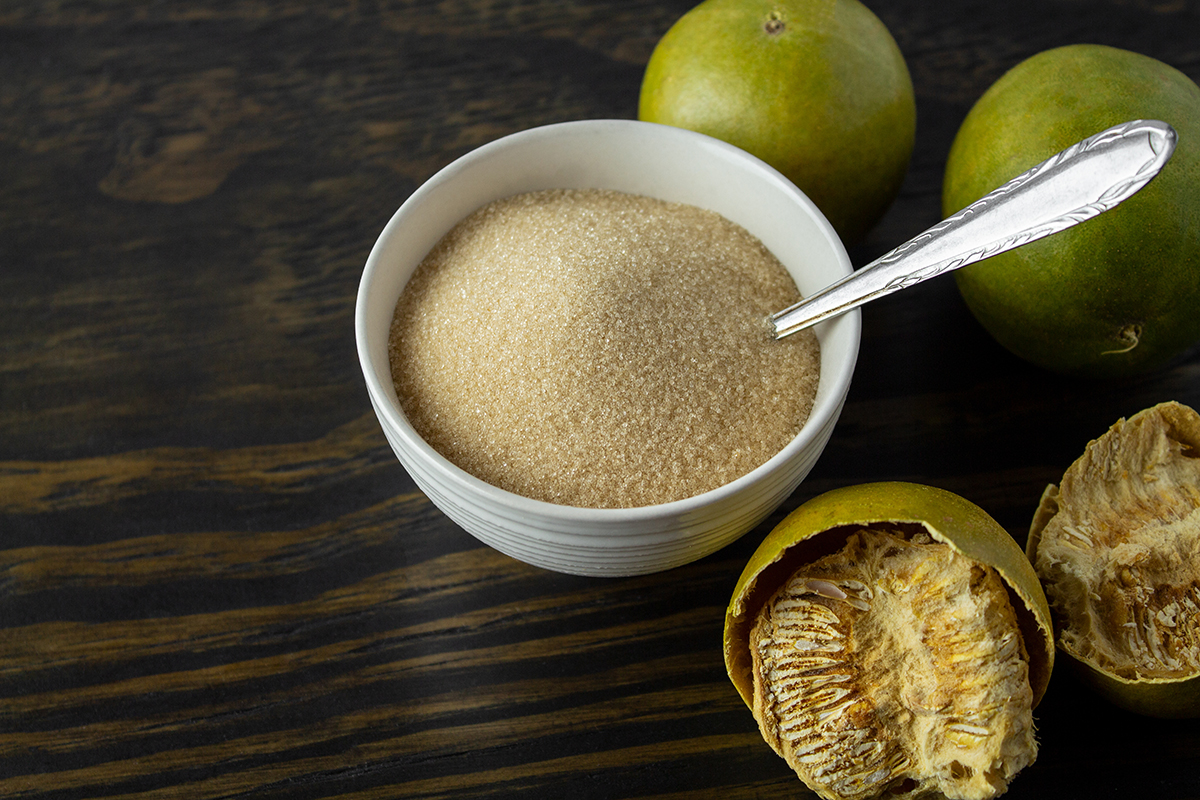
Among the plethora of sugar substitutes that are available, monk fruit sweetener has entered the scene. So what is it and what sets it apart from the extensive list of others?
What is Monk Fruit?
The monk fruit also known as lo han guo in its native China is a small, round fruit that belongs to the same family as gourds like pumpkin and squash. The name monk fruit comes from the monks who discovered it.
Monk fruit has a long history of use as a remedy for colds and digestion. However, its use as a sweetener is fairly new. The fruit’s sweetness comes from natural antioxidant compounds called mogrosides.
How Are Monk Fruit Sweeteners Produced?
The process starts with fresh monk fruit and goes through several steps:
- Processors remove the seeds and skin from fresh monk fruit
- The fruit gets crushed
- The water gets filtered and the sweet mogrosides are extracted and concentrated
- These concentrates are turned into liquid or powdered monk fruit sweetener
What Happens to Monk Fruit Sweeteners in the Body
The mogrosides in monk fruit are non-caloric so they don’t technically get “digested.”
When you consume monk fruit sweeteners, the mogrosides pass through the digestive system without being broken down and are passed through the urine.
What Does Monk Fruit Sweetener Taste Like?
Monk fruit sweetener is characterized by a slightly fruity taste with only a slight aftertaste. The pure extracts are 250 times sweeter than sugar so it’s often blended with other sugar alternatives and bulking agents.
As a result, the taste of monk fruit sweetener can also depend on what it’s blended with.
Most of the monk fruit sweeteners on the market are blended with erythritol, but sometimes it can also be blended with stevia, allulose, xylitol or inulin.
The Benefits of Monk Fruit Sweetener
Monk Fruit Sweetener is Natural
Monk fruit sweetener is natural and free of chemicals and additives unlike other sugar substitutes like saccharin or aspartame.
May Benefit Gut Health
Recent research published in PubMed, suggests that the mogrosides in monk fruit sweetener may act as a prebiotic thus helping to increase the prevalence and activity of probiotic bacterial strains in the gut.
Antioxidant and Anti-Inflammatory
According to this study, mogrosides seem to inhibit oxygen reactive species and neutralize free radicals. In other words, they have antioxidant and anti - inflammatory properties.
Whether monk fruit’s mogrosides can prevent conditions related to oxidative damage has yet to be proven. But this is still important in light of sugar’s inflammatory properties.
Anti-Diabetes Properties
As expected of a sugar alternative, monk fruit sweeteners won’t raise blood-sugar levels. In animal studies, mice were given monk fruit extract and actually experienced lower blood-sugar levels. Other positive health effects in the study included lower oxidative stress and increased HDL (good) cholesterol. The speculation is that these effects are a result of the mogrosides’ ability to stimulate insulin secretion.
The effect is probably not significant and might be even lower when monk fruit sweeteners are mixed with erythritol and bulking agents.
Weight Management
Monk fruit sweeteners don’t metabolize in the body and thus don’t provide any calories. As a result, they could be a tool for weight management. As we’ve previously stated with allulose and erythritol, practicing moderation will be just as important.
For example, even if you replace all of the sugar in cakes or cookies with monk fruit extract, they still have other carbs and calories. A good weight management strategy should involve eating whole foods with lots of fruits and vegetables along with adequate exercise.
Frequently Asked Questions About Monk Fruit Sweetener
Are Monk Fruit Sweeteners Safe?
The US FDA declared monk fruit sweeteners generally recognized as safe in 2010. Additionally monk fruit has been eaten for hundreds of years without reports of negative side effects.
How to Use Monk Fruit Sweetener
As with most alternative sweeteners, you can basically use monk fruit sweeteners the way you would use sugar such as adding it to coffee or tea, baking or adding a touch of additional sweetness to cereal and oatmeal.
Monk fruit extract itself is much sweeter than sugar, and even monk fruit sweeteners with bulking agents probably won’t be a 1:1 match with sugar. With that said, reducing too much of the volume of sugar (25% or so) in baked goods will negatively affect the texture so it’s advised to mix monk fruit sweeteners into a powder to try to make up for this.
One exception where you cannot replace sugar with monk fruit sweetener is for jams and jellies where sugar acts as a preservative.
Monk Fruit Sweetener vs Stevia
Monk Fruit and Stevia are both natural so many will wonder that the difference is and how to choose between them. One hasn’t proven to be definitively healthier than the other so it’s mostly a matter of personal preference.
Some possible considerations include:
- Cost
- Availability
- Taste/flavor
- Allergic reactions to stevia
Through trial and error, you may also find that one sweetener is preferable for your tea and coffee with the other is better for your baking needs. They each have their own strengths and weaknesses in this regard.
Conversion Guidelines
The conversion ratio between monk fruit sweetener and sugar can vary a bit depending on the exact product. Other sweeteners can be mixed in as well as varying amounts of bulking agents.
Most of the time, the conversion is about 1:1 or 1:2.
Bottom Line
Monk Fruit sweeteners are a relatively-new, natural, calorie-free sweetener that provides several possible health benefits. It has several benefits including being calorie free, not spiking blood-glucose levels and neutralizing free radicals.
This article is provided for informational purposes only and is not intended to be used as medical advice. If you have immediate concerns about your health, please seek the help of your physician.
*These statements have not been evaluated by the Food and Drug Administration. Products are not intended to diagnose, treat, cure or prevent disease.




Validate your login
Sign In
Create New Account